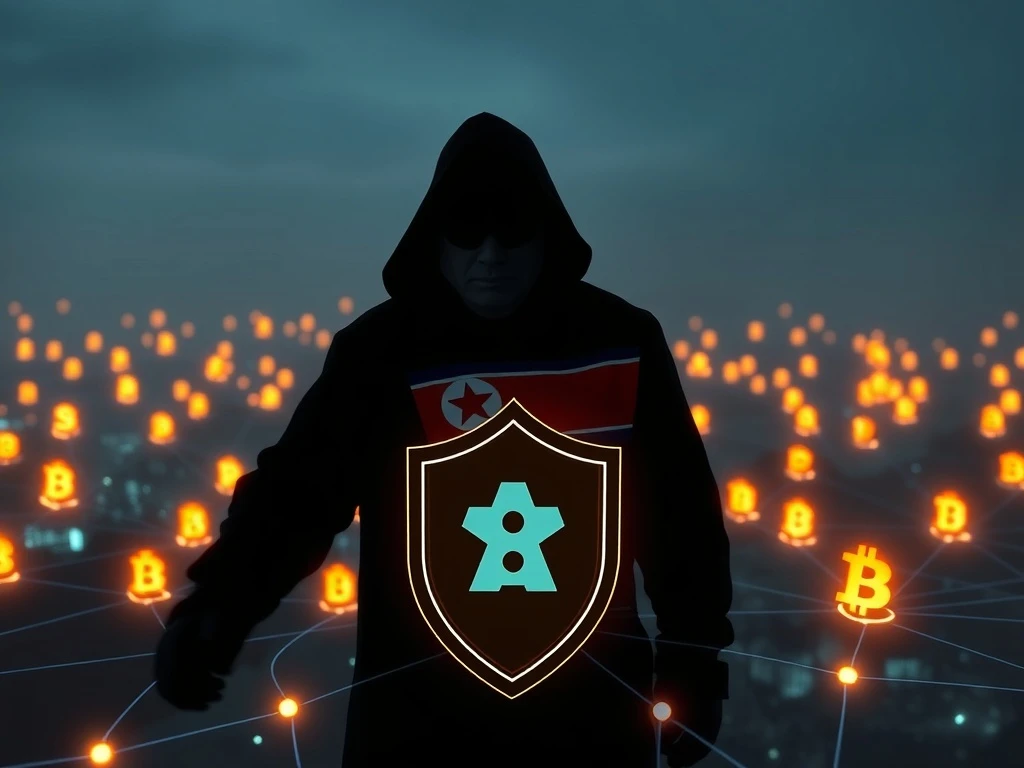Urgent Warning: North Korean Hackers Exposed – 60 Fake IT Workers Threaten Crypto Security

The cryptocurrency world faces an alarming new challenge. Binance co-founder Changpeng “CZ” Zhao recently sounded a critical alarm. He warned about a significant escalation in **North Korean hackers** targeting the industry. This urgent message came after the white hat Security Alliance (SEAL) team uncovered profiles of 60 individuals. These individuals are impersonating IT workers, posing a direct threat to **crypto security** across various platforms.
Binance CZ Issues Urgent Warning on Cyber Infiltration
Changpeng Zhao, widely known as **Binance CZ**, issued a stern warning on X. He highlighted the sophisticated tactics employed by North Korean agents. These agents are stepping up their efforts to infiltrate legitimate cryptocurrency companies. Their primary goal is to gain unauthorized access to sensitive data and assets. This development raises fresh security concerns for the entire industry. Furthermore, it necessitates heightened vigilance from all participants.
CZ detailed several insidious methods these attackers use. First, they pose as job candidates. They seek employment opportunities within development, security, and finance departments. This strategy provides them with a crucial “foot in the door.” Once inside, they can potentially access internal systems. Second, these operatives act as employers. They conduct fake interviews with current employees of crypto firms. During these interviews, they might simulate a Zoom issue. Consequently, they send a malicious link disguised as an “update.” This link contains a virus designed to take over the employee’s device. Moreover, some agents provide coding questions. They then send malicious “sample code” to unsuspecting developers. This code can compromise systems. Other tactics include posing as users to send malicious links to customer support staff. Perhaps most concerning, they even attempt to bribe employees or outsourced vendors for data access. CZ stressed, “To all crypto platforms, train your employees to not download files, and screen your candidates carefully.” This advice is paramount for maintaining robust **cybersecurity threats** defenses.
SEAL Team Uncovers 60 Fake IT Workers
Zhao’s warning coincided with a groundbreaking discovery by the Security Alliance (SEAL). This group of ethical hackers compiled a comprehensive repository. It details the profiles of at least 60 **fake IT workers**. These individuals are confirmed North Korean agents. They use fake names and fabricated identities. Their objective is clear: infiltrate US crypto exchanges. Ultimately, they aim to steal sensitive user data and digital assets.

The SEAL team’s repository is a vital resource. It provides critical information on these impersonators. This includes their aliases, fake names, and email addresses. It also lists their websites, both real and fabricated citizenships, and addresses. Furthermore, it details their locations and even the numbers of firms that unknowingly hired them. Salary details, GitHub profiles, and all other public associations are also included for each impersonator. This level of detail helps firms identify and avoid potential threats. Security Alliance stated, “North Korean developers are eager to work for your company, but it’s important to not get scammed by impostors when hiring.” This proactive measure significantly bolsters **crypto security** efforts across the industry.

The white hat SEAL team formed to combat these exploits. Paradigm researcher Samczsun leads the group. Within a year of its launch, SEAL conducted over 900 hack-related investigations. This demonstrates the growing need for ethical hackers in the digital asset space. Their work is crucial in defending against evolving **cybersecurity threats**.
Coinbase Enhances Defenses Against Persistent North Korean Hackers
The recent warnings from **Binance CZ** follow similar concerns from other major players. Coinbase, for example, reported a new wave of threats last month. This indicates a broader, coordinated campaign by malicious actors. In response, Coinbase CEO Brian Armstrong introduced stringent internal security measures. These measures aim to fortify the exchange’s defenses. They protect both its infrastructure and its users’ assets.
One key requirement mandates all Coinbase workers to receive in-person training in the US. This ensures a consistent and high level of security awareness. Additionally, individuals with access to sensitive systems must hold US citizenship. They also must submit to fingerprinting. These measures represent a significant tightening of security protocols. Armstrong highlighted the scale of the challenge. He noted, “We can collaborate with law enforcement […] but it feels like there’s 500 new people graduating every quarter, from some kind of school they have, and that’s their whole job.” This statement underscores the persistent and organized nature of the threat. It also emphasizes the continuous need for robust **crypto security** strategies.
The Escalating Threat of North Korean Cybersecurity Threats
North Korean state-sponsored hacking groups, most notably the infamous Lazarus Group, are primary suspects behind some of the most devastating cryptocurrency heists. These groups have perfected their craft. They have stolen billions of dollars in digital assets. Their operations are sophisticated, well-funded, and relentless. For instance, they are linked to the $1.4 billion Bybit hack, which remains one of the industry’s largest thefts. This incident highlights their capability and ambition. Moreover, it underscores the severe financial risks involved.
Chainalysis data reveals a disturbing trend. Throughout 2024, **North Korean hackers** stole over $1.34 billion worth of digital assets. This occurred across 47 separate incidents. This figure represents a staggering 102% increase from the $660 million stolen in 2023. Such statistics paint a clear picture of an escalating cyber warfare. These groups actively target the burgeoning Web3 ecosystem. They exploit vulnerabilities in smart contracts, exchange security, and human error. Their actions directly undermine trust in the digital asset space. Consequently, they pose a significant challenge to global financial stability. The ongoing threat from these sophisticated actors demands continuous innovation in **cybersecurity threats** detection and prevention.
Safeguarding the Future: Best Practices for Crypto Security
The warnings from **Binance CZ** and Coinbase, coupled with the SEAL team’s findings, necessitate immediate action. Crypto platforms and individual users must adopt proactive security measures. Employee training is fundamental. Staff must learn to identify phishing attempts and malicious links. They should also understand the dangers of downloading unverified files. Furthermore, rigorous screening processes for job candidates are essential. Companies must verify identities and employment histories meticulously. This helps prevent **fake IT workers** from infiltrating sensitive roles.
For platforms, implementing multi-factor authentication (MFA) is crucial. Regular security audits and penetration testing can identify vulnerabilities before exploitation. Isolating sensitive systems from general networks also adds layers of protection. Moreover, robust incident response plans are vital. These plans ensure a swift and effective reaction to any security breach. Collaboration with cybersecurity firms and law enforcement agencies is equally important. Sharing threat intelligence can create a stronger collective defense against **North Korean hackers** and other malicious actors.
Individuals also play a role in maintaining **crypto security**. They should use strong, unique passwords. Hardware wallets offer superior protection for storing significant amounts of cryptocurrency. Users must remain skeptical of unsolicited messages and links. Verifying sources before clicking or downloading anything is a simple yet powerful defense. Staying informed about the latest **cybersecurity threats** empowers users to protect their assets. Ultimately, a multi-faceted approach involving technology, education, and vigilance will be key to securing the future of cryptocurrency.







